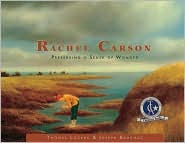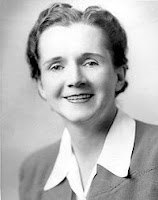These are the images I carry in memory that form my understanding of passion and compassion in science: Rachel Carson waking at midnight to return to the sea the microscopic marine organisms she has been studying, when the tidal cycle is favorable to their survival; John Muir clinging to the upper branches of a tall pine during a violent storm, reveling in the power of natural forces.
The post Passion and compassion: The people who created the words and numbers of environmental science appeared first on OUPblog.
By Robyn Arianrhod
29 November 2012 is the 140th anniversary of the death of mathematician Mary Somerville, the nineteenth century’s “Queen of Science”. Several years after her death, Oxford University’s Somerville College was named in her honor — a poignant tribute because Mary Somerville had been completely self-taught. In 1868, when she was 87, she had signed J. S. Mill’s (unsuccessful) petition for female suffrage, but I think she’d be astonished that we’re still debating “the woman question” in science. Physics, in particular — a subject she loved, especially mathematical physics — is still a very male-dominated discipline, and men as well as women are concerned about it.
 Of course, science today is far more complex than it was in Somerville’s time, and for the past forty years feminist critics have been wondering if it’s the kind of science that women actually want; physics, in particular, has improved the lives of millions of people over the past 300 years, but it’s also created technologies and weapons that have caused massive human, social and environmental destruction. So I’d like to revisit an old debate: are science’s obstacles for women simply a matter of managing its applications in a more “female-friendly” way, or is there something about its exclusively male origins that has made science itself sexist?
Of course, science today is far more complex than it was in Somerville’s time, and for the past forty years feminist critics have been wondering if it’s the kind of science that women actually want; physics, in particular, has improved the lives of millions of people over the past 300 years, but it’s also created technologies and weapons that have caused massive human, social and environmental destruction. So I’d like to revisit an old debate: are science’s obstacles for women simply a matter of managing its applications in a more “female-friendly” way, or is there something about its exclusively male origins that has made science itself sexist?
To manage science in a more female-friendly way, it would be interesting to know if there’s any substance behind gender stereotypes such as that women prefer to solve immediate human problems, and are less interested than men in detached, increasingly expensive fundamental research, and in military and technological applications. Either way, though, it’s self-evident that women should have more say in how science is applied and funded, which means it’s important to have more women in decision-making positions — something we’re still far from achieving.
But could the scientific paradigm itself be alienating to women? Mary Somerville didn’t think so, but it’s often argued (most recently by some eco-feminist and post-colonial critics) that the seventeenth-century Scientific Revolution, which formed the template for modern science, was constructed by European men, and that consequently, the scientific method reflects a white, male way of thinking that inherently preferences white men’s interests and abilities over those of women and non-Westerners. It’s a problematic argument, but justification for it has included an important critique of reductionism — namely, that Western male experimental scientists have traditionally studied physical systems, plants, and even human bodies by dissecting them, studying their components separately and losing sight of the whole system or organism.
The limits of the reductionist philosophy were famously highlighted in biologist Rachel Carson’s book, Silent Spring, which showed that the post-War boom in chemical pest control didn’t take account of the whole food chain, of which insects are merely a part. Other dramatic illustrations are climate change, and medical disasters like the thalidomide tragedy: clearly, it’s no longer enough to focus selectively on specific problems such as the action of a drug on a particular symptom, or the local effectiveness of specific technologies; instead, scientists must consider the effect of a drug or medical procedure on the whole person, whilst new technological inventions shouldn’t be separated from their wider social and environmental ramifications.
In its proper place, however, reductionism in basic scientific research is important. (The recent infamous comment by American Republican Senate nominee Todd Akin — that women can “shut down” their bodies during a “legitimate rape”, in order not to become pregnant — illustrates the need for a basic understanding of how the various parts of the human body work.) I’m not sure if this kind of reductionism is a particularly male or particularly Western way of thinking, but either way there’s much more to the scientific method than this; it’s about developing testable hypotheses from observations (reductionist or holistic), and then testing those hypotheses in as objective a way as possible. The key thing in observing the world is curiosity, and this is a human trait, discernible in all children, regardless of race or gender. Of course, girls have traditionally faced more cultural restraints than boys, so perhaps we still need to encourage girls to be actively curious about the world around them. (For instance, it’s often suggested that women prefer biology to physics because they want to help people — and yet, many of the recent successes in medical and biological science would have been impossible without the technology provided by fundamental, curiosity-driven physics.)
Like Mary Somerville, I think the scientific method has universal appeal, but I also think feminist and other critics are right to question its patriarchal and capitalist origins. Although science at its best is value-free, it’s part of the broader community, whose values are absorbed by individual scientists. So much so that Yale researchers Moss-Racusin et al recently uncovered evidence that many scientists themselves, male and female, have an unconscious sexist bias. In their widely reported study, participants judged the same job application (for a lab manager position) to be less competent if it had a (randomly assigned) female name than if it had a male name.
In Mary Somerville’s day, such bias was overt, and it had the authority of science itself: women’s smaller brain size was considered sufficient to “prove” female intellectual inferiority. It was bad science, and it shows how patriarchal perceptions can skew the interpretation not just of women’s competence, but also of scientific data itself. (Without proper vigilance, this kind of subjectivity can slip through the safeguards of the scientific method because of other prejudices, too, such as racism, or even the agendas of funding bodies.) Of course, acknowledging the existence of patriarchal values in society isn’t about hating men or assuming men hate women. Mary Somerville met with “the utmost kindness” from individual scientific men, but that didn’t stop many of them from seeing her as the exception that proved the male-created rule of female inferiority. After all, it takes analysis and courage to step outside a long-accepted norm. And so, the “woman question” is still with us — but in trying to resolve it, we might not only find ways to remove existing gender biases, but also broaden the conversation about what sort of science we all want in the twenty-first century.
Robyn Arianrhod is an Honorary Research Associate in the School of Mathematical Sciences at Monash University. She is the author of Seduced by Logic: Émilie Du Châtelet, Mary Somerville and the Newtonian Revolution and Einstein’s Heroes.
Subscribe to the OUPblog via email or RSS.
Subscribe to only science and medicine articles on the OUPblog via email or RSS.
View more about this book on the 

Image credit: Mary Somerville. Public domain via Wikimedia Commons.

To begin our day, Sonny the husky and I hit the beach at dawn. We like to honor a sacred passage written by Evelyn Waugh: "In all the diurnal revolution these first fresh hours alone are untainted by man." Completely true. Nothing provides me greater joy than rambling the beach with my old dog in [...]
I have to confess that I didn't know much about Rachel Carson until I moved to the United States in 1992. Since then I have read and been inspired by her books. Here is a review of a book that I read this week.
 Rachel Carson: Preserving a sense of wonder
Rachel Carson: Preserving a sense of wonder
Joseph Bruchac
Illustrated by Thomas Locker
Nonfiction picture book
Ages 6 to 10
Fulcrum Publishing, 2004, 978-1-55591-695-4
When Rachel was a little girl, she lived in Springdale, Pennsylvania, “a town once as lovely as its name.” She had a deep love of books, and through them she developed a interest in the sea. Though writing was what she loved, Rachel studied biology in college. She finally got to see the sea in person and she fell in love with its moods and its stories. Later Rachel wrote about the sea in her first book, Under the Sea-Wind.
All this time Rachel’s once lovely hometown in Pennsylvania, was being poisoned. The rivers were filthy, “the air was choked with smoke,” and poisonous agricultural sprays were killing animals of all kinds. Hearing about this terrible development, Rachel decided to write a new book. This new book, Silent Spring, angered a lot of people, but it also helped many others to see that it is important to protect the environment, and that we all have to do our part to safeguard our planet.
In this truly beautiful picture book, a lyrical and powerful text is perfectly married to Thomas Locker’s gorgeous paintings. Readers will get a memorable picture of what Rachel Carson was like and how important her legacy has been for all of us.
 On May 27th, 1907, A very special little girl, Rachel Carson, came into this world. With her book Silent Spring, Rachel Carson drew attention to the fact that the world's natural recources are not able to tolerate years of abuse forever. Eventually damage is done, and the consequences can be far reaching and permanent. Many people believe Rachel Carson was the person who really got the first environmental movement off the ground. Children can find out about this extraordinary woman by reading Rachel: The story of Rachel Carson by Amy Ehrlich and iIllustrated by Wendell Minor.
On May 27th, 1907, A very special little girl, Rachel Carson, came into this world. With her book Silent Spring, Rachel Carson drew attention to the fact that the world's natural recources are not able to tolerate years of abuse forever. Eventually damage is done, and the consequences can be far reaching and permanent. Many people believe Rachel Carson was the person who really got the first environmental movement off the ground. Children can find out about this extraordinary woman by reading Rachel: The story of Rachel Carson by Amy Ehrlich and iIllustrated by Wendell Minor.




